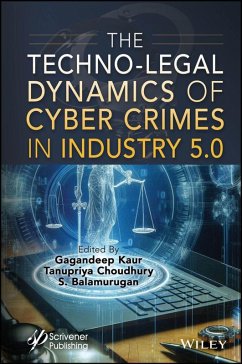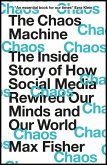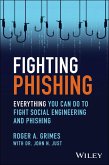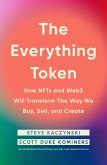The Techno-Legal Dynamics of Cyber Crimes in Industry 5.0 (eBook, ePUB)
Redaktion: Kaur, Gagandeep; Balamurugan, S.; Choudhury, Tanupriya
173,99 €
173,99 €
inkl. MwSt.
Sofort per Download lieferbar

0 °P sammeln
173,99 €
Als Download kaufen

173,99 €
inkl. MwSt.
Sofort per Download lieferbar

0 °P sammeln
Jetzt verschenken
Alle Infos zum eBook verschenken
173,99 €
inkl. MwSt.
Sofort per Download lieferbar
Alle Infos zum eBook verschenken

0 °P sammeln
The Techno-Legal Dynamics of Cyber Crimes in Industry 5.0 (eBook, ePUB)
Redaktion: Kaur, Gagandeep; Balamurugan, S.; Choudhury, Tanupriya
- Format: ePub
- Merkliste
- Auf die Merkliste
- Bewerten Bewerten
- Teilen
- Produkt teilen
- Produkterinnerung
- Produkterinnerung

Bitte loggen Sie sich zunächst in Ihr Kundenkonto ein oder registrieren Sie sich bei
bücher.de, um das eBook-Abo tolino select nutzen zu können.
Hier können Sie sich einloggen
Hier können Sie sich einloggen
Sie sind bereits eingeloggt. Klicken Sie auf 2. tolino select Abo, um fortzufahren.

Bitte loggen Sie sich zunächst in Ihr Kundenkonto ein oder registrieren Sie sich bei bücher.de, um das eBook-Abo tolino select nutzen zu können.
This book explores the core principles, technological advancements, and legal challenges of Industry 5.0's digital transformation.
Industry 5.0 has enhanced the operational efficiency of the entire manufacturing process by incorporating multiple emerging technologies; however, high-tech cybercrimes have prompted legal scholars worldwide to rethink the fundamental principles of technology and law.
The Techno-Legal Dynamics of Cyber Crimes in Industry 5.0 shows how advanced technologies, such as artificial intelligence, the Internet of Things, and robotics, are integrated within…mehr
- Geräte: eReader
- mit Kopierschutz
- eBook Hilfe
- Größe: 3.8MB
Andere Kunden interessierten sich auch für
![The Techno-Legal Dynamics of Cyber Crimes in Industry 5.0 (eBook, PDF) The Techno-Legal Dynamics of Cyber Crimes in Industry 5.0 (eBook, PDF)]() The Techno-Legal Dynamics of Cyber Crimes in Industry 5.0 (eBook, PDF)173,99 €
The Techno-Legal Dynamics of Cyber Crimes in Industry 5.0 (eBook, PDF)173,99 €![Into the Metaverse (eBook, ePUB) Into the Metaverse (eBook, ePUB)]() Cathy HacklInto the Metaverse (eBook, ePUB)8,95 €
Cathy HacklInto the Metaverse (eBook, ePUB)8,95 €![The Future of Hacking (eBook, ePUB) The Future of Hacking (eBook, ePUB)]() Laura S. ScherlingThe Future of Hacking (eBook, ePUB)21,95 €
Laura S. ScherlingThe Future of Hacking (eBook, ePUB)21,95 €![The Chaos Machine (eBook, ePUB) The Chaos Machine (eBook, ePUB)]() Max FisherThe Chaos Machine (eBook, ePUB)7,99 €
Max FisherThe Chaos Machine (eBook, ePUB)7,99 €![Fighting Phishing (eBook, ePUB) Fighting Phishing (eBook, ePUB)]() Roger A. GrimesFighting Phishing (eBook, ePUB)18,99 €
Roger A. GrimesFighting Phishing (eBook, ePUB)18,99 €![The Everything Token (eBook, ePUB) The Everything Token (eBook, ePUB)]() Steve KaczynskiThe Everything Token (eBook, ePUB)14,99 €
Steve KaczynskiThe Everything Token (eBook, ePUB)14,99 €![Embracing the Future: Creative Industries for Environment and Advanced Society 5.0 in a Post-Pandemic Era (eBook, ePUB) Embracing the Future: Creative Industries for Environment and Advanced Society 5.0 in a Post-Pandemic Era (eBook, ePUB)]() Embracing the Future: Creative Industries for Environment and Advanced Society 5.0 in a Post-Pandemic Era (eBook, ePUB)0,00 €
Embracing the Future: Creative Industries for Environment and Advanced Society 5.0 in a Post-Pandemic Era (eBook, ePUB)0,00 €-
-
-
This book explores the core principles, technological advancements, and legal challenges of Industry 5.0's digital transformation.
Industry 5.0 has enhanced the operational efficiency of the entire manufacturing process by incorporating multiple emerging technologies; however, high-tech cybercrimes have prompted legal scholars worldwide to rethink the fundamental principles of technology and law.
The Techno-Legal Dynamics of Cyber Crimes in Industry 5.0 shows how advanced technologies, such as artificial intelligence, the Internet of Things, and robotics, are integrated within manufacturing environments. It explores the intricate relationship between legal systems and technological advancements and addresses the rise of cybercrime following Industry 5.0's digital transformation. Focusing on the interaction between technology and law, the book investigates current cyberlaw issues and solutions. It draws insights from diverse experts, including scholars, legal professionals, and industry leaders, emphasizing effective regulations to minimize cyber threat risks for Industry 5.0.
By adopting an international viewpoint, this book sheds light on various dimensions of nascent cybercrimes and legislative efforts worldwide aimed at governing them effectively.
Audience This book should be read by legal scholars, lawyers, judges, legal and information technology researchers, cybersecurity experts, computer and software engineers, and students of law and technology. Regulators, policymakers, international trade specialists, and business executives should read it as well.
Industry 5.0 has enhanced the operational efficiency of the entire manufacturing process by incorporating multiple emerging technologies; however, high-tech cybercrimes have prompted legal scholars worldwide to rethink the fundamental principles of technology and law.
The Techno-Legal Dynamics of Cyber Crimes in Industry 5.0 shows how advanced technologies, such as artificial intelligence, the Internet of Things, and robotics, are integrated within manufacturing environments. It explores the intricate relationship between legal systems and technological advancements and addresses the rise of cybercrime following Industry 5.0's digital transformation. Focusing on the interaction between technology and law, the book investigates current cyberlaw issues and solutions. It draws insights from diverse experts, including scholars, legal professionals, and industry leaders, emphasizing effective regulations to minimize cyber threat risks for Industry 5.0.
By adopting an international viewpoint, this book sheds light on various dimensions of nascent cybercrimes and legislative efforts worldwide aimed at governing them effectively.
Audience This book should be read by legal scholars, lawyers, judges, legal and information technology researchers, cybersecurity experts, computer and software engineers, and students of law and technology. Regulators, policymakers, international trade specialists, and business executives should read it as well.
Dieser Download kann aus rechtlichen Gründen nur mit Rechnungsadresse in D ausgeliefert werden.
Produktdetails
- Produktdetails
- Verlag: Wiley
- Seitenzahl: 584
- Erscheinungstermin: 6. März 2025
- Englisch
- ISBN-13: 9781394242153
- Artikelnr.: 73584152
- Verlag: Wiley
- Seitenzahl: 584
- Erscheinungstermin: 6. März 2025
- Englisch
- ISBN-13: 9781394242153
- Artikelnr.: 73584152
- Herstellerkennzeichnung Die Herstellerinformationen sind derzeit nicht verfügbar.
Gagandeep Kaur, PhD, is an assistant professor of law at the School of Law, University of Petroleum & Energy Studies, Dehradun, India. She specializes in cyber law, information technology law, cybercrimes, and digital copyright and has over 14 years of teaching and research experience at prestigious universities. She has authored five law books, published more than 100 articles in peer-reviewed journals, and received numerous awards. Tanupriya Choudhury, PhD, is a professor and associate dean of research at Graphic Era (Deemed to be University), Dehradun, India. He has authored more than 150 research papers and filed 25 patents. He serves as the Honorary Secretary of the Indian Engineering Teachers' Association, a Senior Advisor in the INDO-UK Confederation of Science, Technology, and Research Ltd., London, UK, and the International Association of Professional and Fellow Engineers, Delaware, USA. S. Balamurugan, PhD, is the Director of Research and Development at Intelligent Research Consultancy Services (iRCS), Coimbatore, Tamil Nadu, India. He also holds the position of Director at the Albert Einstein Engineering and Research Labs (AEER Labs) and Vice Chairman of the Renewable Energy Society of India (RESI). He has published over 50 books, more than 200 international journal articles and conference papers, and has 35 patents.
Preface xv
1 AI & IP: Ownership Rights in Industry 5.0 1
Pulkit Mogra
1.1 Introduction 2
1.2 Evolution of Artificial Intelligence System 4
1.3 Rights Upon the Fruits of AI: #TheConundrum 8
1.4 The Antidote to Conundrum: Work Made for Hire (WMFH) Model 12
2 Cybersecurity and Crime in Industry 4.0: An Analysis of Legal Aspects of
Cybercrime 19
Jeevesh Sharma and Ashima Jain
2.1 Introduction 20
2.2 Industry 4.0 21
2.3 Cybercrime in the Digital Economy 22
2.4 Cybercrime Statistics--Global Context 24
2.5 Cybersecurity 30
2.6 Legal Perspectives of Cybercrime and Their Penalty-Cases 32
2.7 Challenges of Cybersecurity 36
2.8 Conclusion 38
3 Toward an Intelligent Cybersecurity System: The Role of Machine Learning
43
Oly Mishra and Vijaya Geeta Dharmavaram
3.1 Introduction 44
3.2 Machine Learning Paradigms 45
3.3 Machine Learning Applications 46
3.4 Machine Learning Applications in Cybersecurity 47
3.5 Machine Learning in Cybersecurity--Few Cases 48
3.6 Issues and Limitations of Machine Learning in Cybersecurity 51
3.7 Future Directions 52
3.8 Conclusion 53
4 ATP the New-Age Threat Vector and Cyberattack Trends 55
Akashdeep Bhardwaj and Sam Goundar
4.1 Introducing Advanced Persistent Threats 55
4.2 New-Age APT Attacks 58
4.3 Cyberattacks Trends 65
4.4 Reconnaissance 68
4.5 Initial Compromise 69
4.6 Establishing a Foothold 72
4.7 Exfiltration 73
4.8 Consolidation 75
4.9 Covering Tracks 76
4.10 Conclusion 77
5 Online Privacy in Artificial Intelligence Algorithms: Ethical and Legal
Impacts of Technological Development and Exposure 79
Aditi Bharti and Gagandeep Kaur
5.1 Introduction 80
5.2 Understanding Artificial Intelligence 83
5.3 Impact of Artificial Intelligence on Personal Data 85
5.4 General Data Protection Regulation and Artificial Intelligence 88
5.5 Right to be Forgotten: Legal and Ethical Considerations of Data
Processing by an AI 91
5.6 Conclusion 97
6 Exacerbation and Combat of Cyberattacks: The Dual Paradox of Machine
Learning 101
Devika Sharma and Saket Sharma
6.1 Introduction 102
6.2 Concept of Machine Learning 103
6.3 Technologies Involved in Machine Learning and Their Impact on
Cybersecurity 106
6.4 Growing Role of Machine Learning in Cybersecurity 108
6.5 Applications of Machine Learning in Cybersecurity 109
6.6 Demerits of Using Machine Learning in Cybersecurity 112
6.7 Legal Framework for Cybersecurity in India 113
6.8 Conclusion 115
7 Hacking the System: A Deep Dive into the World of E-Banking Crime 121
Swati Gupta
7.1 Introduction 122
7.2 Literature Review 124
7.3 Combating E-Banking Crimes 135
7.4 E-Banking Crimes: Emerging Economies 138
7.5 Conclusion 142
8 Is Love a Crime-Decoding Cybercrimes in Online Dating and Risk Mitigation
149
Latika Choudhary and Hardik Daga
8.1 Introduction to Online Dating 150
8.2 Cybercrimes via Online Dating 153
8.3 Exploring the Law of India 159
8.4 Laws Governing Dating Apps in India 161
8.5 A Ray of Hope--is Mitigation Possible 165
9 Critical Analysis of the Role of Intermediaries with Respect to
Cybercrimes in Cyberspace 171
Anwesha Pathak
10 Cybercrime and AI: Issues and Solutions 199
Gagandeep Kaur, Darashiny Nivasan and Tanupriya Choudhury
10.1 Introduction 200
10.2 Literature Review 202
10.3 Nature of Artificial Intelligence 206
10.4 Artificial Intelligence Tools for Cybersecurity 209
10.5 Legal Challenges 211
10.6 Comparison of Indian and International Law 215
10.7 Conclusion 228
10.8 Suggestions 229
11 The Illusion of Bitcoin: The Rise and Fall of a Revolutionary
Cryptocurrency 237
Ravi Kant
11.1 Mystery of Bitcoin: An Overview 238
11.2 The Rise and Fall of Bitcoin 240
11.3 The Illusion of Bitcoin 243
11.4 Bitcoin and Cybersecurity 244
11.5 Measures to Enhance Bitcoin Security 246
11.6 Case Studies of Bitcoin Security Breaches 248
11.7 Bitcoin and the Financial Industry 249
11.8 Social and Political Implications of Bitcoin 253
11.9 Bitcoin's Role in Crime 255
11.10 The Future of Bitcoin 257
11.11 Conclusion 259
11.12 Way Forward 260
12 Cybercrime Against Women in India: Challenges and Possible Solutions 265
Avneet Kaur
12.1 Introduction 266
12.2 History and Origin of Cybercrimes 267
12.3 Literature Review 268
12.4 Reasons for the Growth of Cybercrimes Against Women 269
12.5 Different Types of Cybercrime Against Women 273
12.6 Implication of Cybercrimes on Women 275
12.7 Legal Provisions Against Cybercrimes 276
12.8 Provisions for Cybercrimes Under IT ACT 2000 277
12.9 Landmark Cases in Cybercrime Against Women 278
12.10 Shortcomings in the Indian Legal System 280
12.11 Suggestions 281
13 Emerging Legal Challenges in the Artificial World of Metaverse 285
Rajesh Kumar and Megha M. Patel
13.1 Introduction 286
13.2 The Ideas Behind the Metaverse 288
13.3 The Application of the Metaverse in Different Industries 290
13.4 Issues and Challenges after Introducing the Metaverse 293
13.5 Approaching Metaverse Problems from a Global Perspective 298
13.6 Conclusion 305
14 Cyberterrorism: In an Era of Information Warfare 309
Mohamad Ayub Dar and Megha Ojha
14.1 Introduction 310
14.2 The Surge in Cyberterrorism 310
14.3 Background 311
14.4 Methodology Used 314
14.5 Effects of Cyberterrorism on Society and Government 315
14.6 Techniques and Methods Used for Cyberterrorism 317
14.7 Countries Affected the Most by Cyberterrorism 320
14.8 Ukraine and Russia War and Cyberterrorism 321
14.9 Combating Cyberterrorism 324
14.10 Conclusion 327
15 Freedom of Speech and Expression on Social Media--A Comparison of India
and China 331
Sanyogita Singh and Vikram Singh
15.1 Introduction 332
15.2 Review of Literature 336
15.3 Online Speech Regulations--India vs. China 341
15.4 Intermediary Responsibilities--India vs. China 343
15.5 Conclusion 346
16 Environment and Cybercrime in the World: Mitigating the Impact of
Cybercrime on the Environment 351
Pracheta Rathore and Jai Malaviya
16.1 Introduction 352
16.2 Impact of Cybercrime on the Environment 353
16.3 Mitigating the Impact of Cybercrime 358
16.4 Future of the Environment and Cybercrime 364
16.5 Conclusion 368
17 Face Recognition Based on Smart Attendance System Using Python 373
P. Monisha, Prakash N., E. Udayakumar, Tamilselvan S. and Kumareshan N.
17.1 Introduction 374
17.2 Methodology 376
17.3 Face Database 379
17.4 Implementation of CNN and SVM Algorithm 382
17.5 Features and Benefits Features of the System 388
17.6 Conclusion 389
References 390
Index 393
1 AI & IP: Ownership Rights in Industry 5.0 1
Pulkit Mogra
1.1 Introduction 2
1.2 Evolution of Artificial Intelligence System 4
1.3 Rights Upon the Fruits of AI: #TheConundrum 8
1.4 The Antidote to Conundrum: Work Made for Hire (WMFH) Model 12
2 Cybersecurity and Crime in Industry 4.0: An Analysis of Legal Aspects of
Cybercrime 19
Jeevesh Sharma and Ashima Jain
2.1 Introduction 20
2.2 Industry 4.0 21
2.3 Cybercrime in the Digital Economy 22
2.4 Cybercrime Statistics--Global Context 24
2.5 Cybersecurity 30
2.6 Legal Perspectives of Cybercrime and Their Penalty-Cases 32
2.7 Challenges of Cybersecurity 36
2.8 Conclusion 38
3 Toward an Intelligent Cybersecurity System: The Role of Machine Learning
43
Oly Mishra and Vijaya Geeta Dharmavaram
3.1 Introduction 44
3.2 Machine Learning Paradigms 45
3.3 Machine Learning Applications 46
3.4 Machine Learning Applications in Cybersecurity 47
3.5 Machine Learning in Cybersecurity--Few Cases 48
3.6 Issues and Limitations of Machine Learning in Cybersecurity 51
3.7 Future Directions 52
3.8 Conclusion 53
4 ATP the New-Age Threat Vector and Cyberattack Trends 55
Akashdeep Bhardwaj and Sam Goundar
4.1 Introducing Advanced Persistent Threats 55
4.2 New-Age APT Attacks 58
4.3 Cyberattacks Trends 65
4.4 Reconnaissance 68
4.5 Initial Compromise 69
4.6 Establishing a Foothold 72
4.7 Exfiltration 73
4.8 Consolidation 75
4.9 Covering Tracks 76
4.10 Conclusion 77
5 Online Privacy in Artificial Intelligence Algorithms: Ethical and Legal
Impacts of Technological Development and Exposure 79
Aditi Bharti and Gagandeep Kaur
5.1 Introduction 80
5.2 Understanding Artificial Intelligence 83
5.3 Impact of Artificial Intelligence on Personal Data 85
5.4 General Data Protection Regulation and Artificial Intelligence 88
5.5 Right to be Forgotten: Legal and Ethical Considerations of Data
Processing by an AI 91
5.6 Conclusion 97
6 Exacerbation and Combat of Cyberattacks: The Dual Paradox of Machine
Learning 101
Devika Sharma and Saket Sharma
6.1 Introduction 102
6.2 Concept of Machine Learning 103
6.3 Technologies Involved in Machine Learning and Their Impact on
Cybersecurity 106
6.4 Growing Role of Machine Learning in Cybersecurity 108
6.5 Applications of Machine Learning in Cybersecurity 109
6.6 Demerits of Using Machine Learning in Cybersecurity 112
6.7 Legal Framework for Cybersecurity in India 113
6.8 Conclusion 115
7 Hacking the System: A Deep Dive into the World of E-Banking Crime 121
Swati Gupta
7.1 Introduction 122
7.2 Literature Review 124
7.3 Combating E-Banking Crimes 135
7.4 E-Banking Crimes: Emerging Economies 138
7.5 Conclusion 142
8 Is Love a Crime-Decoding Cybercrimes in Online Dating and Risk Mitigation
149
Latika Choudhary and Hardik Daga
8.1 Introduction to Online Dating 150
8.2 Cybercrimes via Online Dating 153
8.3 Exploring the Law of India 159
8.4 Laws Governing Dating Apps in India 161
8.5 A Ray of Hope--is Mitigation Possible 165
9 Critical Analysis of the Role of Intermediaries with Respect to
Cybercrimes in Cyberspace 171
Anwesha Pathak
10 Cybercrime and AI: Issues and Solutions 199
Gagandeep Kaur, Darashiny Nivasan and Tanupriya Choudhury
10.1 Introduction 200
10.2 Literature Review 202
10.3 Nature of Artificial Intelligence 206
10.4 Artificial Intelligence Tools for Cybersecurity 209
10.5 Legal Challenges 211
10.6 Comparison of Indian and International Law 215
10.7 Conclusion 228
10.8 Suggestions 229
11 The Illusion of Bitcoin: The Rise and Fall of a Revolutionary
Cryptocurrency 237
Ravi Kant
11.1 Mystery of Bitcoin: An Overview 238
11.2 The Rise and Fall of Bitcoin 240
11.3 The Illusion of Bitcoin 243
11.4 Bitcoin and Cybersecurity 244
11.5 Measures to Enhance Bitcoin Security 246
11.6 Case Studies of Bitcoin Security Breaches 248
11.7 Bitcoin and the Financial Industry 249
11.8 Social and Political Implications of Bitcoin 253
11.9 Bitcoin's Role in Crime 255
11.10 The Future of Bitcoin 257
11.11 Conclusion 259
11.12 Way Forward 260
12 Cybercrime Against Women in India: Challenges and Possible Solutions 265
Avneet Kaur
12.1 Introduction 266
12.2 History and Origin of Cybercrimes 267
12.3 Literature Review 268
12.4 Reasons for the Growth of Cybercrimes Against Women 269
12.5 Different Types of Cybercrime Against Women 273
12.6 Implication of Cybercrimes on Women 275
12.7 Legal Provisions Against Cybercrimes 276
12.8 Provisions for Cybercrimes Under IT ACT 2000 277
12.9 Landmark Cases in Cybercrime Against Women 278
12.10 Shortcomings in the Indian Legal System 280
12.11 Suggestions 281
13 Emerging Legal Challenges in the Artificial World of Metaverse 285
Rajesh Kumar and Megha M. Patel
13.1 Introduction 286
13.2 The Ideas Behind the Metaverse 288
13.3 The Application of the Metaverse in Different Industries 290
13.4 Issues and Challenges after Introducing the Metaverse 293
13.5 Approaching Metaverse Problems from a Global Perspective 298
13.6 Conclusion 305
14 Cyberterrorism: In an Era of Information Warfare 309
Mohamad Ayub Dar and Megha Ojha
14.1 Introduction 310
14.2 The Surge in Cyberterrorism 310
14.3 Background 311
14.4 Methodology Used 314
14.5 Effects of Cyberterrorism on Society and Government 315
14.6 Techniques and Methods Used for Cyberterrorism 317
14.7 Countries Affected the Most by Cyberterrorism 320
14.8 Ukraine and Russia War and Cyberterrorism 321
14.9 Combating Cyberterrorism 324
14.10 Conclusion 327
15 Freedom of Speech and Expression on Social Media--A Comparison of India
and China 331
Sanyogita Singh and Vikram Singh
15.1 Introduction 332
15.2 Review of Literature 336
15.3 Online Speech Regulations--India vs. China 341
15.4 Intermediary Responsibilities--India vs. China 343
15.5 Conclusion 346
16 Environment and Cybercrime in the World: Mitigating the Impact of
Cybercrime on the Environment 351
Pracheta Rathore and Jai Malaviya
16.1 Introduction 352
16.2 Impact of Cybercrime on the Environment 353
16.3 Mitigating the Impact of Cybercrime 358
16.4 Future of the Environment and Cybercrime 364
16.5 Conclusion 368
17 Face Recognition Based on Smart Attendance System Using Python 373
P. Monisha, Prakash N., E. Udayakumar, Tamilselvan S. and Kumareshan N.
17.1 Introduction 374
17.2 Methodology 376
17.3 Face Database 379
17.4 Implementation of CNN and SVM Algorithm 382
17.5 Features and Benefits Features of the System 388
17.6 Conclusion 389
References 390
Index 393
Preface xv
1 AI & IP: Ownership Rights in Industry 5.0 1
Pulkit Mogra
1.1 Introduction 2
1.2 Evolution of Artificial Intelligence System 4
1.3 Rights Upon the Fruits of AI: #TheConundrum 8
1.4 The Antidote to Conundrum: Work Made for Hire (WMFH) Model 12
2 Cybersecurity and Crime in Industry 4.0: An Analysis of Legal Aspects of
Cybercrime 19
Jeevesh Sharma and Ashima Jain
2.1 Introduction 20
2.2 Industry 4.0 21
2.3 Cybercrime in the Digital Economy 22
2.4 Cybercrime Statistics--Global Context 24
2.5 Cybersecurity 30
2.6 Legal Perspectives of Cybercrime and Their Penalty-Cases 32
2.7 Challenges of Cybersecurity 36
2.8 Conclusion 38
3 Toward an Intelligent Cybersecurity System: The Role of Machine Learning
43
Oly Mishra and Vijaya Geeta Dharmavaram
3.1 Introduction 44
3.2 Machine Learning Paradigms 45
3.3 Machine Learning Applications 46
3.4 Machine Learning Applications in Cybersecurity 47
3.5 Machine Learning in Cybersecurity--Few Cases 48
3.6 Issues and Limitations of Machine Learning in Cybersecurity 51
3.7 Future Directions 52
3.8 Conclusion 53
4 ATP the New-Age Threat Vector and Cyberattack Trends 55
Akashdeep Bhardwaj and Sam Goundar
4.1 Introducing Advanced Persistent Threats 55
4.2 New-Age APT Attacks 58
4.3 Cyberattacks Trends 65
4.4 Reconnaissance 68
4.5 Initial Compromise 69
4.6 Establishing a Foothold 72
4.7 Exfiltration 73
4.8 Consolidation 75
4.9 Covering Tracks 76
4.10 Conclusion 77
5 Online Privacy in Artificial Intelligence Algorithms: Ethical and Legal
Impacts of Technological Development and Exposure 79
Aditi Bharti and Gagandeep Kaur
5.1 Introduction 80
5.2 Understanding Artificial Intelligence 83
5.3 Impact of Artificial Intelligence on Personal Data 85
5.4 General Data Protection Regulation and Artificial Intelligence 88
5.5 Right to be Forgotten: Legal and Ethical Considerations of Data
Processing by an AI 91
5.6 Conclusion 97
6 Exacerbation and Combat of Cyberattacks: The Dual Paradox of Machine
Learning 101
Devika Sharma and Saket Sharma
6.1 Introduction 102
6.2 Concept of Machine Learning 103
6.3 Technologies Involved in Machine Learning and Their Impact on
Cybersecurity 106
6.4 Growing Role of Machine Learning in Cybersecurity 108
6.5 Applications of Machine Learning in Cybersecurity 109
6.6 Demerits of Using Machine Learning in Cybersecurity 112
6.7 Legal Framework for Cybersecurity in India 113
6.8 Conclusion 115
7 Hacking the System: A Deep Dive into the World of E-Banking Crime 121
Swati Gupta
7.1 Introduction 122
7.2 Literature Review 124
7.3 Combating E-Banking Crimes 135
7.4 E-Banking Crimes: Emerging Economies 138
7.5 Conclusion 142
8 Is Love a Crime-Decoding Cybercrimes in Online Dating and Risk Mitigation
149
Latika Choudhary and Hardik Daga
8.1 Introduction to Online Dating 150
8.2 Cybercrimes via Online Dating 153
8.3 Exploring the Law of India 159
8.4 Laws Governing Dating Apps in India 161
8.5 A Ray of Hope--is Mitigation Possible 165
9 Critical Analysis of the Role of Intermediaries with Respect to
Cybercrimes in Cyberspace 171
Anwesha Pathak
10 Cybercrime and AI: Issues and Solutions 199
Gagandeep Kaur, Darashiny Nivasan and Tanupriya Choudhury
10.1 Introduction 200
10.2 Literature Review 202
10.3 Nature of Artificial Intelligence 206
10.4 Artificial Intelligence Tools for Cybersecurity 209
10.5 Legal Challenges 211
10.6 Comparison of Indian and International Law 215
10.7 Conclusion 228
10.8 Suggestions 229
11 The Illusion of Bitcoin: The Rise and Fall of a Revolutionary
Cryptocurrency 237
Ravi Kant
11.1 Mystery of Bitcoin: An Overview 238
11.2 The Rise and Fall of Bitcoin 240
11.3 The Illusion of Bitcoin 243
11.4 Bitcoin and Cybersecurity 244
11.5 Measures to Enhance Bitcoin Security 246
11.6 Case Studies of Bitcoin Security Breaches 248
11.7 Bitcoin and the Financial Industry 249
11.8 Social and Political Implications of Bitcoin 253
11.9 Bitcoin's Role in Crime 255
11.10 The Future of Bitcoin 257
11.11 Conclusion 259
11.12 Way Forward 260
12 Cybercrime Against Women in India: Challenges and Possible Solutions 265
Avneet Kaur
12.1 Introduction 266
12.2 History and Origin of Cybercrimes 267
12.3 Literature Review 268
12.4 Reasons for the Growth of Cybercrimes Against Women 269
12.5 Different Types of Cybercrime Against Women 273
12.6 Implication of Cybercrimes on Women 275
12.7 Legal Provisions Against Cybercrimes 276
12.8 Provisions for Cybercrimes Under IT ACT 2000 277
12.9 Landmark Cases in Cybercrime Against Women 278
12.10 Shortcomings in the Indian Legal System 280
12.11 Suggestions 281
13 Emerging Legal Challenges in the Artificial World of Metaverse 285
Rajesh Kumar and Megha M. Patel
13.1 Introduction 286
13.2 The Ideas Behind the Metaverse 288
13.3 The Application of the Metaverse in Different Industries 290
13.4 Issues and Challenges after Introducing the Metaverse 293
13.5 Approaching Metaverse Problems from a Global Perspective 298
13.6 Conclusion 305
14 Cyberterrorism: In an Era of Information Warfare 309
Mohamad Ayub Dar and Megha Ojha
14.1 Introduction 310
14.2 The Surge in Cyberterrorism 310
14.3 Background 311
14.4 Methodology Used 314
14.5 Effects of Cyberterrorism on Society and Government 315
14.6 Techniques and Methods Used for Cyberterrorism 317
14.7 Countries Affected the Most by Cyberterrorism 320
14.8 Ukraine and Russia War and Cyberterrorism 321
14.9 Combating Cyberterrorism 324
14.10 Conclusion 327
15 Freedom of Speech and Expression on Social Media--A Comparison of India
and China 331
Sanyogita Singh and Vikram Singh
15.1 Introduction 332
15.2 Review of Literature 336
15.3 Online Speech Regulations--India vs. China 341
15.4 Intermediary Responsibilities--India vs. China 343
15.5 Conclusion 346
16 Environment and Cybercrime in the World: Mitigating the Impact of
Cybercrime on the Environment 351
Pracheta Rathore and Jai Malaviya
16.1 Introduction 352
16.2 Impact of Cybercrime on the Environment 353
16.3 Mitigating the Impact of Cybercrime 358
16.4 Future of the Environment and Cybercrime 364
16.5 Conclusion 368
17 Face Recognition Based on Smart Attendance System Using Python 373
P. Monisha, Prakash N., E. Udayakumar, Tamilselvan S. and Kumareshan N.
17.1 Introduction 374
17.2 Methodology 376
17.3 Face Database 379
17.4 Implementation of CNN and SVM Algorithm 382
17.5 Features and Benefits Features of the System 388
17.6 Conclusion 389
References 390
Index 393
1 AI & IP: Ownership Rights in Industry 5.0 1
Pulkit Mogra
1.1 Introduction 2
1.2 Evolution of Artificial Intelligence System 4
1.3 Rights Upon the Fruits of AI: #TheConundrum 8
1.4 The Antidote to Conundrum: Work Made for Hire (WMFH) Model 12
2 Cybersecurity and Crime in Industry 4.0: An Analysis of Legal Aspects of
Cybercrime 19
Jeevesh Sharma and Ashima Jain
2.1 Introduction 20
2.2 Industry 4.0 21
2.3 Cybercrime in the Digital Economy 22
2.4 Cybercrime Statistics--Global Context 24
2.5 Cybersecurity 30
2.6 Legal Perspectives of Cybercrime and Their Penalty-Cases 32
2.7 Challenges of Cybersecurity 36
2.8 Conclusion 38
3 Toward an Intelligent Cybersecurity System: The Role of Machine Learning
43
Oly Mishra and Vijaya Geeta Dharmavaram
3.1 Introduction 44
3.2 Machine Learning Paradigms 45
3.3 Machine Learning Applications 46
3.4 Machine Learning Applications in Cybersecurity 47
3.5 Machine Learning in Cybersecurity--Few Cases 48
3.6 Issues and Limitations of Machine Learning in Cybersecurity 51
3.7 Future Directions 52
3.8 Conclusion 53
4 ATP the New-Age Threat Vector and Cyberattack Trends 55
Akashdeep Bhardwaj and Sam Goundar
4.1 Introducing Advanced Persistent Threats 55
4.2 New-Age APT Attacks 58
4.3 Cyberattacks Trends 65
4.4 Reconnaissance 68
4.5 Initial Compromise 69
4.6 Establishing a Foothold 72
4.7 Exfiltration 73
4.8 Consolidation 75
4.9 Covering Tracks 76
4.10 Conclusion 77
5 Online Privacy in Artificial Intelligence Algorithms: Ethical and Legal
Impacts of Technological Development and Exposure 79
Aditi Bharti and Gagandeep Kaur
5.1 Introduction 80
5.2 Understanding Artificial Intelligence 83
5.3 Impact of Artificial Intelligence on Personal Data 85
5.4 General Data Protection Regulation and Artificial Intelligence 88
5.5 Right to be Forgotten: Legal and Ethical Considerations of Data
Processing by an AI 91
5.6 Conclusion 97
6 Exacerbation and Combat of Cyberattacks: The Dual Paradox of Machine
Learning 101
Devika Sharma and Saket Sharma
6.1 Introduction 102
6.2 Concept of Machine Learning 103
6.3 Technologies Involved in Machine Learning and Their Impact on
Cybersecurity 106
6.4 Growing Role of Machine Learning in Cybersecurity 108
6.5 Applications of Machine Learning in Cybersecurity 109
6.6 Demerits of Using Machine Learning in Cybersecurity 112
6.7 Legal Framework for Cybersecurity in India 113
6.8 Conclusion 115
7 Hacking the System: A Deep Dive into the World of E-Banking Crime 121
Swati Gupta
7.1 Introduction 122
7.2 Literature Review 124
7.3 Combating E-Banking Crimes 135
7.4 E-Banking Crimes: Emerging Economies 138
7.5 Conclusion 142
8 Is Love a Crime-Decoding Cybercrimes in Online Dating and Risk Mitigation
149
Latika Choudhary and Hardik Daga
8.1 Introduction to Online Dating 150
8.2 Cybercrimes via Online Dating 153
8.3 Exploring the Law of India 159
8.4 Laws Governing Dating Apps in India 161
8.5 A Ray of Hope--is Mitigation Possible 165
9 Critical Analysis of the Role of Intermediaries with Respect to
Cybercrimes in Cyberspace 171
Anwesha Pathak
10 Cybercrime and AI: Issues and Solutions 199
Gagandeep Kaur, Darashiny Nivasan and Tanupriya Choudhury
10.1 Introduction 200
10.2 Literature Review 202
10.3 Nature of Artificial Intelligence 206
10.4 Artificial Intelligence Tools for Cybersecurity 209
10.5 Legal Challenges 211
10.6 Comparison of Indian and International Law 215
10.7 Conclusion 228
10.8 Suggestions 229
11 The Illusion of Bitcoin: The Rise and Fall of a Revolutionary
Cryptocurrency 237
Ravi Kant
11.1 Mystery of Bitcoin: An Overview 238
11.2 The Rise and Fall of Bitcoin 240
11.3 The Illusion of Bitcoin 243
11.4 Bitcoin and Cybersecurity 244
11.5 Measures to Enhance Bitcoin Security 246
11.6 Case Studies of Bitcoin Security Breaches 248
11.7 Bitcoin and the Financial Industry 249
11.8 Social and Political Implications of Bitcoin 253
11.9 Bitcoin's Role in Crime 255
11.10 The Future of Bitcoin 257
11.11 Conclusion 259
11.12 Way Forward 260
12 Cybercrime Against Women in India: Challenges and Possible Solutions 265
Avneet Kaur
12.1 Introduction 266
12.2 History and Origin of Cybercrimes 267
12.3 Literature Review 268
12.4 Reasons for the Growth of Cybercrimes Against Women 269
12.5 Different Types of Cybercrime Against Women 273
12.6 Implication of Cybercrimes on Women 275
12.7 Legal Provisions Against Cybercrimes 276
12.8 Provisions for Cybercrimes Under IT ACT 2000 277
12.9 Landmark Cases in Cybercrime Against Women 278
12.10 Shortcomings in the Indian Legal System 280
12.11 Suggestions 281
13 Emerging Legal Challenges in the Artificial World of Metaverse 285
Rajesh Kumar and Megha M. Patel
13.1 Introduction 286
13.2 The Ideas Behind the Metaverse 288
13.3 The Application of the Metaverse in Different Industries 290
13.4 Issues and Challenges after Introducing the Metaverse 293
13.5 Approaching Metaverse Problems from a Global Perspective 298
13.6 Conclusion 305
14 Cyberterrorism: In an Era of Information Warfare 309
Mohamad Ayub Dar and Megha Ojha
14.1 Introduction 310
14.2 The Surge in Cyberterrorism 310
14.3 Background 311
14.4 Methodology Used 314
14.5 Effects of Cyberterrorism on Society and Government 315
14.6 Techniques and Methods Used for Cyberterrorism 317
14.7 Countries Affected the Most by Cyberterrorism 320
14.8 Ukraine and Russia War and Cyberterrorism 321
14.9 Combating Cyberterrorism 324
14.10 Conclusion 327
15 Freedom of Speech and Expression on Social Media--A Comparison of India
and China 331
Sanyogita Singh and Vikram Singh
15.1 Introduction 332
15.2 Review of Literature 336
15.3 Online Speech Regulations--India vs. China 341
15.4 Intermediary Responsibilities--India vs. China 343
15.5 Conclusion 346
16 Environment and Cybercrime in the World: Mitigating the Impact of
Cybercrime on the Environment 351
Pracheta Rathore and Jai Malaviya
16.1 Introduction 352
16.2 Impact of Cybercrime on the Environment 353
16.3 Mitigating the Impact of Cybercrime 358
16.4 Future of the Environment and Cybercrime 364
16.5 Conclusion 368
17 Face Recognition Based on Smart Attendance System Using Python 373
P. Monisha, Prakash N., E. Udayakumar, Tamilselvan S. and Kumareshan N.
17.1 Introduction 374
17.2 Methodology 376
17.3 Face Database 379
17.4 Implementation of CNN and SVM Algorithm 382
17.5 Features and Benefits Features of the System 388
17.6 Conclusion 389
References 390
Index 393







